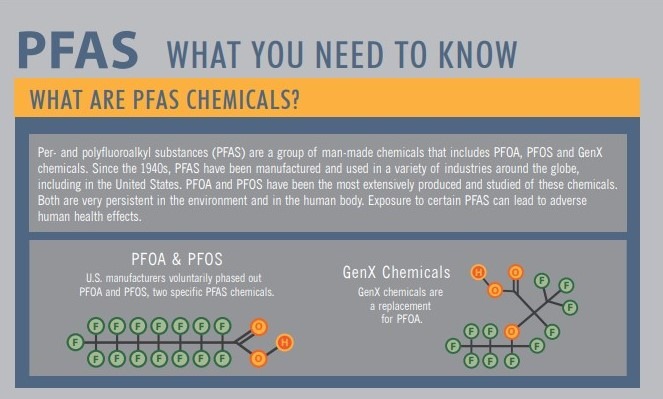What are PFAS?
Dec 10, 2019
Per- and polyfluoroalkyl substances (PFAS) are a complex group of over 3,000 man-made fluorinated organic chemicals that have been used worldwide since the 1940s in industry and consumer products such as non-stick cookware, water-repellent clothing, stain resistant fabrics and carpets, cosmetics, firefighting foams, and products that resist grease, water, and oil.
The most studied PFAS are perfluorooctanoic acid (PFOA) and perfluorooctane sulfonic acid (PFOS). PFOA and PFOS have been phased out of production and use in the United States but may still be manufactured and used in other countries.
During production and use, PFAS can migrate into the soil, water, and air. Most PFAS (including PFOA and PFOS) are resistant to degradation, so they do not breakdown in the environment. As a result of their widespread use and persistence, PFAS are present at low concentrations in the environment and many food products. Additionally, PFAS are found in the blood of humans and animals throughout the world.

Potential Adverse Health Affects
Studies indicate that PFOA and PFOS can cause reproductive and developmental, liver and kidney, and immunological effects in laboratory animals. Both chemicals have caused tumors in animals. The most consistent findings are increased cholesterol levels among exposed populations. Some studies in humans with PFAS exposure have shown that certain PFAS may:
- Affect growth, learning, and behavior of infants and older children;
- Lower a woman’s chance of getting pregnant;
- Interfere with the body’s natural hormones;
- Affect the immune system; and
- Increase the risk of cancer.
More research is needed to allow scientists to fully understand how PFAS affect human health.
Sampling and Analysis Challenges
There are significant challenges related to sample collection and analysis of PFAS including:
- PFAS are ubiquitous, and therefore the potential for cross-contamination is very high;
- PFAS are present in much of the equipment, products, and clothing used for sampling such as Teflon bailers, waterproof coatings on work boots, and Tyveks, cosmetics, moisturizers, sunscreen, insect repellant, and fabric softener;
- The quantification levels for PFAS are in the parts per trillion range. For context, this is equal to approximately ½-drop of oil in 6 million gallons of water;
- EPA Method 537.1 is the current analytical standard for detecting PFAS in drinking water and contains specific requirements for sample containers, collection, preservation, shipping, and holding times;
- EPA has not published a standard method for PFAS analysis in media other than drinking water. As a result, some laboratories are developing modified methods based on EPA Method 537; and
- Set up costs for laboratory sample preparation and analysis instrumentation is significant – a minimum of $500,000.
Regulatory Efforts
In 2016 EPA issued a lifetime health advisory of 70 parts per trillion for PFOS and PFOA in drinking water. Currently, multiple agencies are developing strategies to address concerns associated with PFAS. The EPA has implemented a national action plan which includes efforts in the areas of research, implementation of national drinking water standards, monitoring and cleanup, toxics, enforcement, and risk communication. In November 2019 , EPA released for a 45-day public comment period for a Systematic Review Protocol for five PFAS toxicity assessments being developed under the Integrated Risk Management Information System (IRIS) Program. In September 2019, EPA sent two regulatory proposals on PFAS for interagency review. It is anticipated that by the end of 2019 EPA will release its proposed regulatory determination for PFOS and PFOA, which is the next step involved in setting a drinking water standard under the Safe Drinking Water Act.
For more detailed information regarding PFAS please visit the following links:
- epa.gov/pfas
- pfas-1.itrcweb.org/fact-sheets/
- waste360.com/public-agencies/epa-continues-work-pfas-action-plan